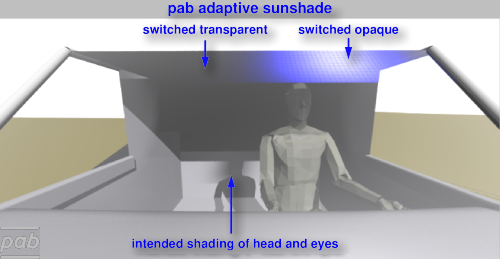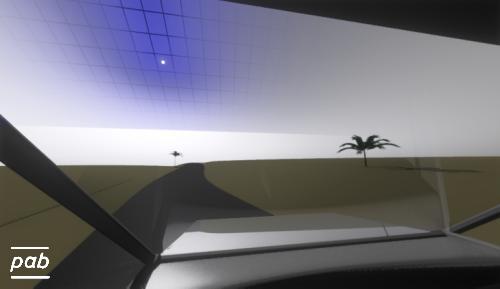



Historical note: This idea had been conceived by me while working at the Fraunhofer Institute for Solar Energy Systems, Freiburg, Germany.
Patent No DE0019705498A1 was granted to the Fraunhofer Society in Germany, Application
Date 13.02.1997 , Publication Date 27.08.1998 .
After some years, the patent was transferred to me, and I kept it alive for some years after that.
Ultimately, due to lack of interest from industry, it expired.
For reference, check the official web-site of the German Patent Office at
www.depatisnet.de.
There's a search function on their web-page, enter the patent ID and check.
So, while it is technically perfectly valid for others to ignore it, it is not correct, for some companies, to claim at a later
date that they had been the first to that idea. Whether due to a lack of research or plain commercial arrogance, they were, in
fact, not. Ass aid, you are welcome to check above patent and decide for yourself.
Direct sunlight disables the view for a driver when driving towards the sun, especially at dusk or dawn. Physiologically, the scattering of light in the eye causes glare and hinders perception of a large and important portion of the visual field. Obviously, a shade is beneficial, but it should obstruct the view as little as possible. Hence the direct line between the eyes and the sun should be shaded, but not more.
The windscreen of a vehicle, airplane, train, etc, typically the upper part of it, is divided into segments, whose optical transmission is switchable between an opaque and a transparent state. An embedded logic to control which of the segments is switched opaque, depending on the driver's head position and the position of the sun. Both can be captured easily by cameras or other sensors. The shaded region is thus given by a line from each eye towards the sun intersecting the surface of the windshield.
 |  |
 |  |
In this simulation, the transmission of the switchable segments was chosen to illustrate the principle. For real applications, the ''dark'' state of the segments has to have a transmission a couple of decades below the transmissive state. The size of the segments depend on the technology of the segments, the sensors involved and the control system. It can be well smaller than in this simulation, shading just the sun and its circum-solar radiation. Additionally, reflexes off buildings can be shaded as well.
 |  |
 |  |
This actively switched, adaptive sunshade works in any combination of driver position, glass windshield. Ranging from the nearly vertical
windscreen of a truck to the inclined window of a sport car.
This simulation demonstrates the principle, using the very coarse CAD model of a vehicle that is rotated around a vertical axis.
Local parameters are: Latitude 55N, March 15th, 12:00 local time, Perez sky model, a clear day with high Cirrus clouds, clearness=3,
brightness=0.2.
As said, this simulation was done in 2003 using a crude CAD Model, however it does demonstrate the principle:
|
driver's view |
|
outside view |